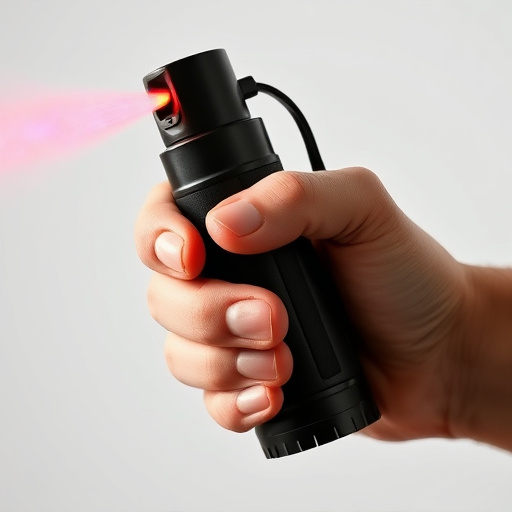TL;DR: Capsaicin in pepper spray irritates pets through mucous membrane contact. Symptoms range from drooling to respiratory distress. Immediate rinse with water dilutes capsaicin. Mild cases treated with calamine or aloe vera, severe reactions require veterinary care. Prevention involves keeping pets indoors and securely storing pepper spray. Regular grooming helps remove residual spray. Accidental exposure requires a thorough wash and monitoring for persistent symptoms.
“Capsaicin inflammatory agent deterrent spray, often used as a non-lethal self-defense measure, can inadvertently harm pets. This article guides you through understanding capsaicin’s effects on animals, recognizing exposure, and offering effective treatment options for affected pet skin. We also explore prevention strategies to safeguard your pets from pepper spray encounters. By learning how and when pets might come in contact with this irritant and implementing preventative measures, you can better protect your beloved companions.”
- Understanding Capsaicin and Its Effects on Pets
- When and How Pepper Spray Exposure Happens
- Treating and Caring for Affected Pet Skin
- Prevention Strategies: Protecting Your Pets from Pepper Spray
Understanding Capsaicin and Its Effects on Pets
Capsaicin, the active compound found in chili peppers, is a well-known inflammatory agent known for its pungent heat. While it’s commonly used as a deterrent in pepper spray for self-defense purposes, it can also pose risks to pets if exposed. When pets come into contact with capsaicin, especially in concentrated forms like pepper spray, they may experience severe irritation and inflammation. Symptoms can range from excessive drooling, pawing at the face, and tears to more intense reactions such as vomiting, diarrhea, and difficulty breathing.
Treating pets exposed to capsaicin requires immediate action. Rinsing the affected area with large amounts of water is crucial to dilute the chemical. In cases of severe irritation or respiratory distress, seeking veterinary care is essential. Veterinarians can provide supportive care, administer fluids, and prescribe medications to alleviate discomfort and prevent complications. It’s important for pet owners to keep pepper spray out of reach and consider alternative deterrents to ensure a safe environment for their furry companions.
When and How Pepper Spray Exposure Happens
Pepper spray exposure happens when capsaicin, the active ingredient in hot peppers, comes into contact with mucous membranes or open wounds. This can occur during direct spraying, as well as through indirect contact, such as touching contaminated surfaces and then rubbing eyes or nose. For pets, exposure is often accidental, happening when they encounter or inhale pepper spray used for deterrence or self-defense purposes.
Treating pets exposed to pepper spray requires immediate action. Rinse the affected area thoroughly with water, focusing on the eyes, mouth, and nose. This helps to dilute the capsaicin and alleviate discomfort. Seek veterinary care if symptoms persist or worsen, as severe reactions can include respiratory distress, excessive panting, or inflammation. Providing a calm, quiet environment and ensuring access to fresh water can also aid in the recovery process for pets exposed to pepper spray.
Treating and Caring for Affected Pet Skin
When pets are exposed to capsaicin inflammatory agent deterrent spray, it’s crucial to take immediate action to treat and care for their affected skin. The first step is to rinse the area thoroughly with warm water to dilute the pepper spray residue. This process helps alleviate irritation and discomfort. After rinsing, gently pat the skin dry with a soft, clean towel, avoiding rubbing which can exacerbate the issue.
For mild cases, over-the-counter topical creams or lotions containing calamine or aloe vera can provide relief from itching and inflammation. However, for more severe reactions, it’s advisable to consult a veterinarian who may prescribe stronger antihistamines or corticosteroids to manage swelling and irritation. Additionally, keeping the affected area clean and monitoring for any signs of infection is essential in the recovery process of pets exposed to pepper spray.
Prevention Strategies: Protecting Your Pets from Pepper Spray
If your pet is exposed to capsaicin inflammatory agent deterrent spray, it’s crucial to act swiftly in treating them. The first step in preventing any adverse effects is to ensure your pets aren’t in direct contact with the spray. This includes keeping them indoors when using such sprays outdoors and storing them securely out of reach. Regular grooming can also help; washing their fur and paws thoroughly after outdoor activities can remove any residual spray.
In case of accidental exposure, remove any visible spray immediately using water or a neutralizing solution recommended for capsaicin poisoning. Monitor your pet for symptoms like coughing, sneezing, or difficulty breathing. If persistent issues arise, seek veterinary care promptly. Treating Pets Exposed to Pepper Spray is essential to ensure their well-being and comfort after such an incident.
Pepper spray, a potent inflammatory agent, can cause significant distress in pets. Understanding its effects and implementing preventive strategies are key to keeping your furry companions safe. If exposure occurs, prompt treatment is essential for Treating Pets Exposed to Pepper Spray. By following the care instructions outlined in this article, you can help alleviate symptoms and ensure your pet’s skin heals effectively. Remember, prevention is always better than cure, so take proactive steps to protect them from this irritant.
